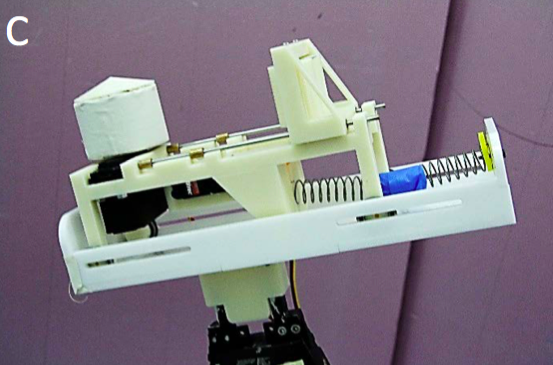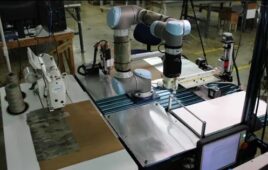Have you ever built custom furniture? It can be a dangerous, expensive and tedious process. Researchers at MIT CSAIL, however, have created a robot-assisted carpentry system called AutoSaw to, hopefully one day, democratize custom furniture building.
AutoSaw consists of OnShape’s CAD system, a modified Roomba Create outfitted with a circular saw and two Kuka youBots, which Kuka stopped manufacturing in 2016. At the moment, AutoSaw can only make chairs, desks and tables. But MIT hopes to expand its capabilities to larger furniture and add drilling and gluing capabilities.
AutoSaw is applying computer numerical control (CNC) technology, which is used in larger scale machinery. CNC converts designs into numbers that are then fed to specially programmed tools to execute. With AutoSaw, users select a template from the CAD software and adjust it to their liking, tweaking the size and shape.
Read MIT’s Paper: Robot Assisted Carpentry for Mass Customization
This design is then turned into instructions for the robots. The jigsaw-rigged Roomba Create can cut lumber of any shape on a plank, while the youBots transport and lift the wood onto a chop saw.

AutoSaw’s Cutting Process
The wood is then autonomously cut to the appropriate lengths. To cut lumber, MIT uses a Vicon positioning system and previously developed planning algorithms. MIT said its used the youBots because of their small footprint and cost compared to larger robot arms.
Related: MIT Develops VR Robot Control System
To cut lumber, the robots are assigned a length and a spec for the dimensioned lumber. The robots identify the lumber using Vicon markers and position themselves one-quarter of the way in from each side. They lift their grippers in place, grab the lumber and then lift further to separate the lumber from its stand.
The robots then form a fleet, and move towards the saw in a synchronized and coordinated fashion. Once near the saw, they move down towards the height of the chop saw’s base plane. They proceed to move slightly past the back plane of the chop saw and lower the lumber down. Because the grippers have compliance, the lumber aligns to the chop saw. The realignment occurs as long as the position of the grippers can be within a tolerance window.

youBots transfer the wood to be cut. (Credit: Jason Dorfman/MIT CSAIL)
Once the lumber is placed on the chop saw, the youBots re-grasp the wood. They position themselves at the expected center of mass location for the two pieces of post-cut lumber. One robot then releases its grip and acts as a support while the other robot uses its gripper to adjust the position of the wood so the desired length of lumber is left on one side of the blade. The support robot re-grasps and the chop saw is activated. Once the part is cut, the desired length of lumber is transported to the user, and the other is returned to the stock.
AutoSaw’s Custom Grippers
The youBots each have a special complaint gripper (see below) that can clamp onto the material, drive the material along a direction, and are complaint perpendicular to the major axis of the lumber. When lumber is placed in the gripper, a force perpendicular to the lumber and parallel to the gripper can cause the gripper to shift its grip. The chop saw is automated by attaching a relay to the 120V line and a linear actuator is attached to the saw. Both are connected to a ROS node via a micro- controller.

AutoSaw custom soft gripper. (Credit: Jason Dorfman/MIT CSAIL)
“We added soft grippers to the robots to give them more flexibility, like that of a human carpenter,” said CSAIL postdoc Jeffrey Lipton, a lead author on a paper about AutoSaw. “This meant we could rely on the accuracy of the power tools instead of the rigid-bodied robots.”
After the robots finish with cutting, the user then assembles their new piece of furniture using step-by-step directions from the system. Lipton, who trained as a carpenter in high school, said AutoSaw is all about exploring what technology can do to make working with wood easier and more productive. But this isn’t the first time MIT has built furniture assembling robots.
Building Upon MIT’s IKEABot
In 2013, MIT showed off the IKEABot that, you guessed it, autonomously assembled flat-pack IKEA furniture. IKEABot also used Kuka youBots to autonomously build IKEA furniture in as little as 10 minutes. AutoSaw also took inspiration from InstantCAD, software developed at MIT that makes it easier to tweak designs by automatically calculating things like internal stress and resistance.
IKEABot infers how furniture parts fit together based on hole positions. Then it plans a sequence of assembly steps for multiple youBots. The robots distribute tasks based on delivery and assembly roles. Assembly robots are equipped with a system of modular tools that fit onto the youBot’s gripper like a glove. The screwing device seen here can be docked when it is not in use. After the assembly is complete, the robots coordinate motions to flip over the table.
“There have been many recent AI achievements in virtual environments, like playing Go and composing music,” says Hod Lipson, a professor of mechanical engineering and data science at Columbia University. “Systems that can work in unstructured physical environments, such as this carpentry system, are notoriously difficult to make. This is truly a fascinating step forward.”
AutoSaw is a proof-of-concept at this point, but simulations showed the robot could build a table with an accuracy comparable to a human, without a real hand ever getting near a blade.
“Our aim is to democratize furniture-customization,” says Adriana Schulz, an MIT researcher who worked on AutoSaw. “We’re trying to open up a realm of opportunities so users aren’t bound to what they’ve bought at Ikea. Instead, they can make what best fits their needs.”





Tell Us What You Think!